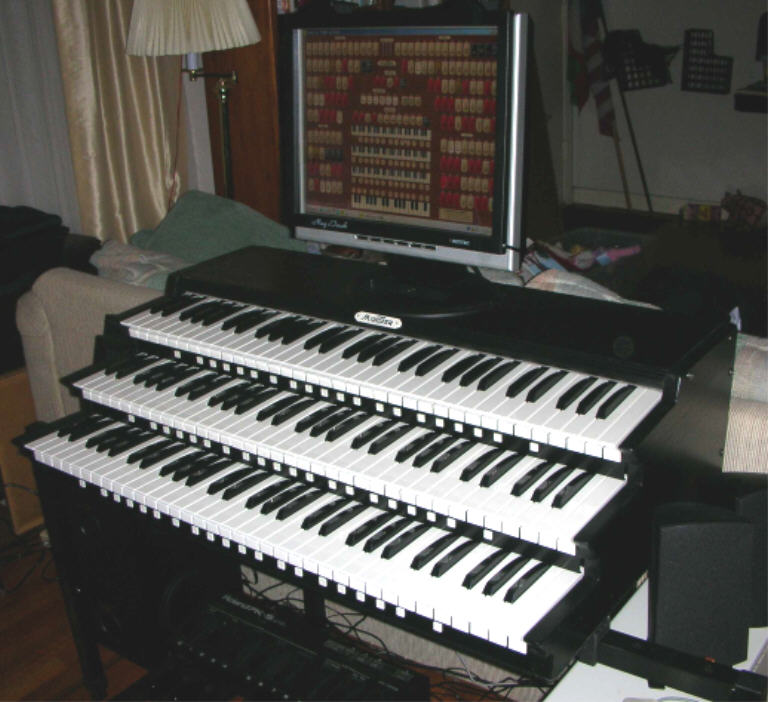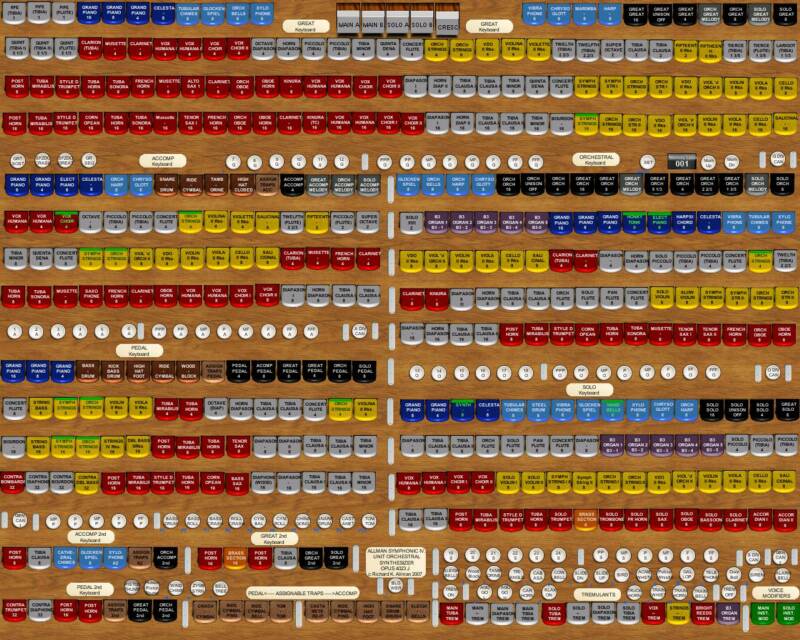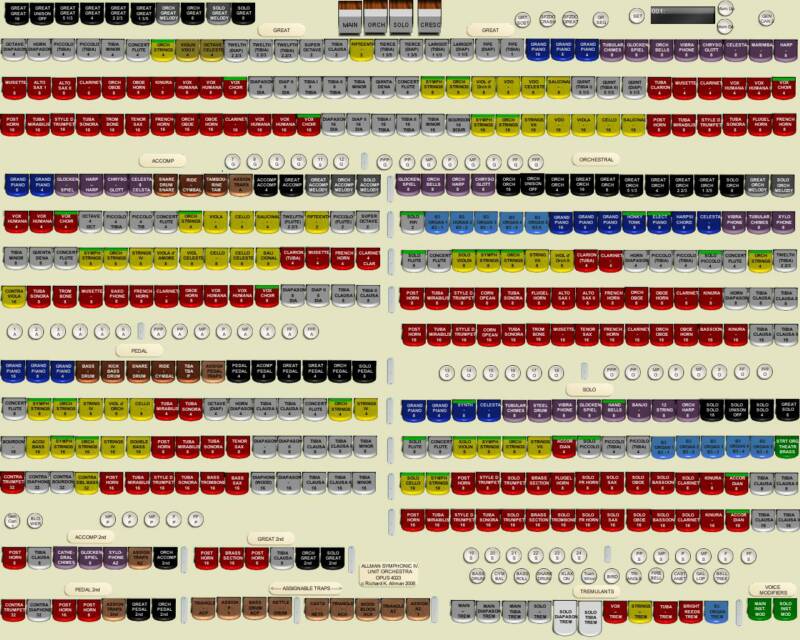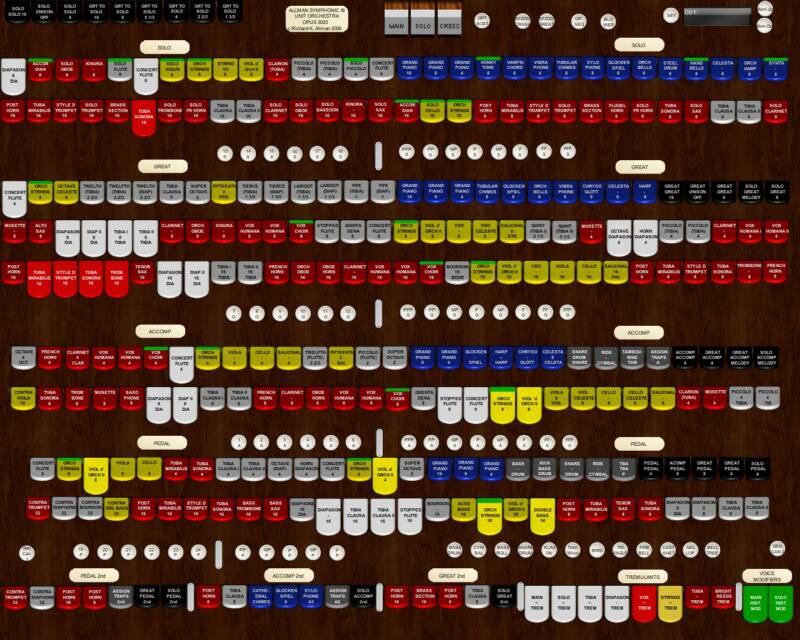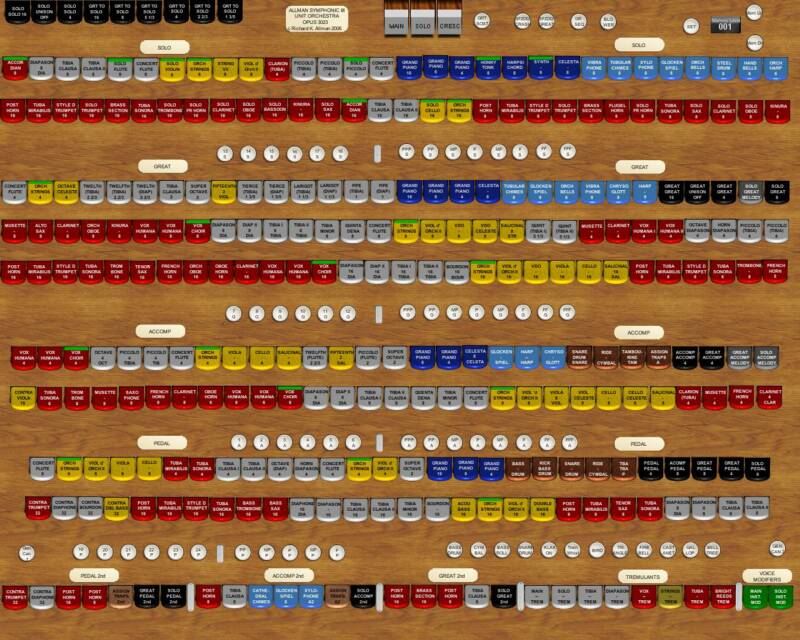Universal VTPO Sound Font Project
With the recent release of the Bret Milan's Hauptwerk Virginia VTPO and the release of the Milan Digital MW 3/31 VTPO for Hauptwerk, there has been a lot of discussion in the forums over the need for a high quality Stereo Theatre Pipe Organ Sound Font that can be used for the MidiTzer and jOrgan to achieve a similar sound quality. If you have any recordings in stereo of an individual Theatre Pipe Organ rank or ranks and have sampled every pipe with 3+ second stereo samples with 2 seconds in between notes. I am willing to act as a clearing house to help the VTPO community build a high quality Universal sound font for everyone to use. If you upload the recordings to the FTP link below, I will volunteer to do the processing of the rank(s) into a Universal Sound Font for MidiTzer and jOrgans VTPO's. What I'm willing to do is remove the blower, wind leakage and background noise from the samples, looping the samples, terracing (balance) the rank(s) and compile them to the Universal Sound Font.
If you have any stereo sample recordings which you think may have too much background, blower or wind noise, please upload them anyway, I have some extremely good software that might be able to remove virtually all background noise without hurting the quality or fidelity of the actual pipe sounds.
Please Click Here for instructions on how to use the Vienna 2.3 Sound Font Editor
Here is another instruction link on the Vienna 2.3 Sound Font Editor
The FTP link is: ftp://72.29.87.235/incoming For IE 6 and earlier, when the link opens simply copy the file from your computer and paste it on to the open FTP page window where you will see an existing instruction file there already, be sure to paste on an open, blank area on the page, not on or over top of the instruction file or other files. If you try to paste over an area near one of the existing files your "paste" option will be greyed out and won't work. For IE 7 once you've clicked on the link and are on the FTP page, click on "View" and "Open FTP page in Explorer" then paste your files to a blank area on the page. Be Sure that the Internet Explorer: Tools\Internet Options\Advanced\"Use Passive FTP (for firewall and DSL Modem compatability)" is turned on (checked). Please email me with the details of your upload at: rkallman@allmanmusic.com
With your help we can bring a very high quality free stereo sound font to life for our VTPO community that we can all use and enjoy with our MidiTzer and jOrgans.
Best Regards,
The Background Colors On All of the Allman Symphonic and Theatre Organ Consoles are Easily Changed with 7 Color Choices Available For Your Viewing Preference
Recent Update History
06/26/07 Added Tremmed Sample Version of Barton Tibia Clausa and Wurl Diapason to SymphIV soundfont, minor changes to Symphonic IV disposition.
06/07/07 Updates for the SymphIV 4CHe sound font, Cornopean is back in, reduced size of the font a little.
05/28/07 Posted USF Wurlitzer Solo Tibia Clausa with Tremmed Samples and Comparison Font with both LFO and Tremmed sample version. Fixed release pop issue with Miditzer Fluid Synth on Wurlitzer Tibia, SymphIV, Barton Vox and Violin sound fonts.
05/26/07 Posted USF Wurlitzer Solo Tibia Clausa, Added same to Symph IV sound font
05/21/07 Made a number of stop changes to Symph IV arraingment, rebalanced Symph IV sound font.
05/20/07 New USF Barton Tibia, Tuba Horn, RM Violin and New Symph IV 4ChSBc includes all new USF ranks Published.
05/16/07 Made adjustments to Trems all fonts to eliminate "Thumping" (over modulation) in Miditzer Fluid Synth
05/14/07 Changed EPH to new USF WurliTzer EPH from Lafyette Theatre Changed Tibia I to Barton Tibia. Major revisions to Trems in sound font, added harmonic filters to trems to achieve "Tremelo Overblown pipe" effect, added quasi pipe release effects to all other samples.
04/21/07 Revisions to Symph IV SB4CH Disposition, SB4CH Sound Font, USF Toy Counther Sound font
04/07/07 Posted the new 4 Chamber version of the Symphonic 4 made for 2 to 4 SB sound cards that can run on much lower powered computers.
3/28/07 Added many new instruments and sounds to the Toy Counter, added new Toy Counter pistons to Symph IV 4CH Sound Font
03/24/07 Minor updates to the Symp. IV Disposition and Solo and Main soundfonts.
12/31/06 Added element definitions to Symph IV and 3-14 SB
12/03/06 Seperated the sound font into Main, Solo and Orchestral fonts, Added some new stops to Symph IV
11/19/06 Fixed Sal 2' on 3-14's Fixed Solo Cello 16' on Symph III, Revoiced Sound font Tibia's.
Installation Tips for the Allman Symphonic and Theatre jOrgan Dispositions Full Version Download
Updated 4/15/07
The Allman Symphonic and Theatre dispositions are written to be run with a minimum screen resolution of 1268 x 1024 with at least a 15" or larger monitor. A 19" or larger monitor is highly recommended. Any other resolution settings such as 800 x 600 etc. will require that you adjust the scaling percentage up or down in the disposition's console properties to fit everything on to the screen.
Hardware recommendations: What I've found that works best for me is to use two or more of the older Creative Sound Blaster cards (Emu 1010 processor series) in the computer for the sound sources. With the KX drivers you can easily run 4 of the sound cards in a computer which brings the polyphony to 256 which works quite well. Something else that works even better is to off load some of the CPU load to a second computer which is used to run 2 or more of the the Creative Sound blaster Cards. When multiple computers are used, it leaves the main computer to run the jOrgan main program and the Orchestral and Bombarde chambers through 1 or 2 (preferred) Sound Blaster Cards. With this arraignment you can also run much lower powered computers. The additional advantage to using 2 or more computers is that you can have many more separate outputs for 8+ front and 8+ rear channels plus 4+ subwoofers. This means you will have a Stereo pair of channels for each of the 4 Chambers. In addition you will also have 8 channels of Surround sound for the Reverb which when tweaked a little can give you some very impressive results. If you opt for the full blown 2 computer, 4 or more sound card solution I don't think that you will be disappointed in the results.
Basic Installation:
Download jOrgan236.zip and put it into the c:\ root directory. It will look like: c:\jOrgan236.zip. When you unzip the jOrgan236.zip file it should create the new directory c:\JOrgan236 on your C: drive. All files and subfolders should end up in: C:\jOrgan236 for everything to work properly.
Caution: If you've previously installed jOrgan ver. 2.2 or another version, be sure to rename the old directory to another name, otherwise Java will try to load the old disposition from the original directory. When this happens the old disposition from the original installation will be corrupted and unusable.
Before you can run jOrgan you will need to set up all of the support programs, Especially Java for jOrgan to work.
FIRST:
Go to the C:\jOrgan236\“Support Programs” directory and run each of the install programs and/or shortcuts in each of the folders starting with the
a. Java 1.5 installation Please Note: The preferred method is to use the offline manual install version to install. You can also go the the www.Java.com website for an online installation version.
b. Midi Ox
c. Midi Yoke
d. KX Drivers
d. SFZ Synth
e. ASIO4All
f. Ethernet Midi
g. Copy the shortcuts from C:\JOrgan236\Shortcuts folder to your desktop.
NOTE: I’ve already done the majority of the setup of the preliminary items in the Zip File you installed for steps 1 through 6 that are contained in the Bruce Miles "Read Me" notes which are included.
Preparation for 1st Run:
To run the Symphonic IV SB4CH four manual console you will need to start, load and configure a minimum of 1 (preferably 4 or more) Sound Blaster cards . Other options are to use a combination of SFZ soft synthesizers and sound cards to produce the sound for the organ. The SFZ's have the advantage of much more polyphony at the expense of much higher CPU and memory usage.
Load the Symphonic IV SB4CH sound font into both A and B Synths of each card. The Main and Orchestral chambers (sound sources) should be run on the card(s) on the left side of the room. The Solo and Bombarde chambers (sound sources) should be run on the card(s) for the right side of the room.
Symphonic IV Usage with 2 Sound Blaster Cards with A&B Synths: (default disposition configuration)
Load the Symphonic IV SB4CH Sound font into Bank 26 of all the Soundblaster cards in both the A&B Synths.
Normally the Main (Synth a) and Orchestral (Synth b) chambers (sound sources) should be on the SB card(s) that feed the left side of the room. The Solo (Synth a) and Bombarde (Synth b) chambers (sound sources) should be located on the card(s) that feed the right side of the room.
Symphonic IV Usage with 1 Sound Blaster Card and 2 SFZ Soft Synths : (Optional configuration)
Note: You will need to change the sound source device setting for the Main and Solo Sound sources from Creative labs Synth (x) to NT! for Main, NT2 for Solo.
Allman Theatre 3-14SB console, load the Symphonic IV SB4CH sound font into bank 26 of your Sound Blaster card, both a & b Synths if available.
skip to step "G" below Please Note: If you run the 3-14 SB console with a single Sound Blaster card you will be limited to 64 note Polyphony per SB card. The primary purpose for the 3-14SB console is to enable you to test your setup to help you get everything working. It is highly recommended that you use the 3-14 SFZ version for your instrument instead of the 3-14 SB or use 2 or more Sound Blaster cards.
To run the Allman Theatre 3-14SFZ console load only 1 instance of SFZ in steps A through G.
To run the Allman Symphonic III console, only load 2 instances of SFZ in steps A through G or use 2 Sound Blaster Cards.
SFZ Soft Synth Setup (if used):
a. The 1st SFZ Synth input should be set to Midi Yoke NT1 for the Main sound source, the 2nd SFZ Synth input should be Midi Yoke NT2, change the Main and Solo sound source device setting to Nt1 and Nt2 respectively. Use the Soundblaster card hardware Synths for the Orchestral (Synth a) and Bombarde (Synth b) chambers. Load the Symphonic SB4CH Sound font into Bank 26 of the Soundblaster card in both A&B Synths.
b. Be sure to load the Sound Font File from C:\JOrgan236\Sound fonts\ Allman Symphonic IV SB4ch.sf2 to each of the SFZ Synths.
c. Set the SFZ Output for each of the SFZ’s to your Sound Card’s ASIO input(s).
d. Set each of the SFZ Synths to 128 or more Polyphony
e. Leave each of the SFZ Synths in the “Draft Mode” unless you own a super computer. :)
f. Steps A through D. will need to be repeated each time you start a new session of jOrgan unless you save the SFZ configuration.
G. The last thing to do before you can play the Symphonic or Theatre 3-14 jOrgan is to set up the "Midi Merger" in jOrgan to accept keyboard inputs. Left click on the jOrgan "View" tab and select "configuration". Next, expand the tree under "Midi" and select "Midi-Merger". In the Midi-Merger window select your midi input hardware such as the MOTU, Roland or which ever midi to USB or midi to game port hardware converter you are using to bring your keyboard midi information into your computer. Once this is done you should see the Midi red and green activity lights blink in the bottom right hand corner of your screen each time you press a key or pedal down. Once you've finished this step you should be ready to play the jOrgan. Please note: Step "G" once it has been set the first time won't have to be repeated again.
Note: to see the full screen version of the console press the "F11" key. The "F11" key toggles you between the full screen and selection screen mode of jOrgan.
NOTE: Since this Sound font at 128MB is quite large, you may have to adjust the Windows Registry "Paged Pool Size" for it to load properly. This edit is strictly try-at-your-own-risk, so be sure to back up your registry and set a new restore point before you do this!
The registry edit is designed for large servers that need to cache very large files (or a large number of small files) in memory for long periods of time, since that's exactly what we're trying to do when we load a large sound font, it works for us too.
This link explains it: http://www.microsoft.com/technet/prodtechnol/windows2000serv/reskit/regentry/46653.mspx?mfr=true
The edit is: HKEY_LOCAL_MACHINE\SYSTEM\CurrentControlSet\Control\Session Manager\Memory Management\Paged Pool Size
The default value is 0x00000000, set the new value to 0xffffffff
I recommend that you use "MIDI" to link the second computer to the first through Midi Ox/Yoke. I’ve also included the Ethernet Midi program in the jOrgan23 Folder that you can use to link the separate computer main keyboard computer. The Midi link is basically bullet proof and works very well, the Ethernet Midi can sometimes lose packets and cause ciphers I've found.
Ethernet Midi Hookup:
Connect the two computers via Ethernet through a little Ethernet switch or hub to each other, then use the Ethernet Midi utilities (be sure to run 2 instances of it) to export the midi streams for NT1 and NT2 out to the second computer where you run the Main and Solo SFZ Synths. Use the Midi Yoke patch panel on the second computer to route the midi from each of the Ethernet Midi's output to each of the SFZ Synths just like you would do on the main computer. I send Ethernet Midi from the first utility program out to NT3 (in) which I patch to NT1 (out) through Midi Yoke for the first SFZ. The second Ethernet Midi I send to NT4 (in) and patch to NT2 (out) for the second SFZ. The second computer doesn't have to be a super fast monster but it should have at least a P4 2 Ghz with 1 Gig of ram.
Midi Yoke with Midi Ox can also be used to send MIDI data from a sound source out to another computer to it's sound card or Soft Synth by using the Ethernet Midi utility or USB ports.
Please Print and study the "Read Me First" instructions under C:\JOrgan236\Installation Instructions before you try to run JOrgan
If you can’t get JOrgan running after you’ve read all of the notes from Bruce Miles in the "Read Me" file, Please go to the jOrgan web site at http://jorgan.sourceforge.net/doku.php and read through the various sections to get more familiar with how jOrgan works.
Notes on some of the features of the Allman Symphonic III, IV jOrgan Dispositions (consoles):
1. Melody couplers play the highest note of your chord at unison with a voice from another selected manual.
2. The Orch to Great Sub Oct Melody Coupler plays the lowest note of the chord your playing on the Great with a voice at 16’ from the Orchestral manual. Useful for two voice harmony when you play the top note melody voice using the Solo to Great Melody Coupler with fill in voices underneath in the chord from the Great.
3. The Green tabs above the Trem section labeled "Main Inst. Mod" will change the Orchestral String stops to Slow Orch Strings, the Vox Choir stop to Vox Choir II "Solo Inst. Mod" will change the "Solo Flute" to Pan Flute, the HonkyTonk Piano to Rinky Tink Piano, the Harpsichord to Coupled Harpsichord, the Synth to Synth II, the Accordion to French Accordion, and the Hand Bells change to Melody Bells, the Solo Violin to Slow Solo Violin, Full Theatre Brass to Straight Organ and the Symphonic Strings I Change to Slow Symphonic Strings
4. The console (disposition) has a 99+ level capture action memory system currently with 24+ generals and 41+ divisional pistons. This will eventually grow to over 100 pistons with 36+ Generals and 50+ Divisional Pistons.
Note: For the most part, the Allman SympIV alpha23a sound font is patch number and voice compatible with the Bruce Mile's and John Tay's sound fonts for the 216 / 260 jOrgan dispositions and Jim Henry's Miditzer 216 / 260 Organs with a few minor exceptions.
.
 | ||||
This page was last updated on: May 21, 2008
Allman Music Sells Discount: Baritones / Euphoniums, Bassoons, Bugles, Cellos, Clarinets, Cornets, Flutes, French Horns, Flugel Horns, Keyboards, Oboes, Saxophones, Sousaphones, Tubas, Trumpets, Trombones, Violins, and Violas from: Amati, Bach, Barclay, Barrington, Besson, Blessing, Bohland-Fuchs, Buffet, Cerveny, Conn, Gemeinhardt, Getzen, Hofner, Holton, Iolite, Jupiter, King, Keilwerth, Maestro, Monique, Olds, Paesold, Schreiber, Schroetter, Selmer, Steltz, Stevens, Stowasser, Strunal, Winston and Yamaha
Allman Symphonic III, IV Orchestral Synthesizers and Theater 3-14 jOrgan Virtual Theatre Pipe Organs
If you experience any problems with this Web site
Product Index:
Speaker Repair
Home, Pro & Car Audio
Email For:
(c) 2000-2007 Advanced SuperiorTechnologies Inc.
All Rights Reserved
Virtual Pipe Organs aren't necessarily designed to replace an actual pipe or electronic organ, however, they can be used very effectively as a very low cost practice organ with the addition of a couple of low cost "Midi" Keyboards and pedals. If a Virtual organ is added to an existing Organ's console it can add a tremendous amount of new sounds and features that previously cost many thousands of dollars with proprietary "Digitally Sampled Sound Modules".
The Virtual Theatre Pipe Organ can also completely replace or augment the older analog electronic voices in a huge number of older "Home Instruments" for a fraction of the cost of a new Digital Organ!
The jOrgan (Java Organ), MidiTzer and Hauptwerk are Landmark breakthroughs in logical Midi relay control software! Sven Meier who developed the jOrgan, Jim Henry who developed the Miditzer and Martin Dyde who developed Hauptwerk should be highly praised for all of their hard work. The jOrgan and Hauptwerk can control 16, 32, 48, or more independent midi channels simultaneously on each keyboard by selecting instrument tabs (stops) or by using the combination pistons while playing live, just like the real thing! In addition, actual samples or sound font recordings of individual Pipe Organ ranks along with other actual instruments can be used with the jOrgan, Miditzer or Hauptwerk for incredibly authentic sound quality.
The Miditzer is the easiest virtual organ to set up. It is completely self contained and doesn't require any additional hardware or software to run. The jOrgan software is meant for a little more advanced computer user because of the slightly more complex installation setup required. The Hauptwerk is the most advanced of the virtual pipe organs and requires a fairly high powered computer to run it. One of the biggest advantages that jOrgan and Hauptwerk have, is that they are fully configurable. This means that you can build your own Virtual Pipe Organ to your particular specifications just as I did with my 4-54 version. The jOrgan and Hauptwerk organs are very easy to configure to read physical stop, piston and swell shoe inputs from your existing hardware. The Hauptwerk can even be used to output signals that can be used to drive physical stop tabs (SAMS) through magnet drivers which makes it a complete organ control relay and combination action system. Since the jOrgan and Hauptwerk are both fully configurable, they can also be easily used to control actual ranks of pipes in conjunction with the electronic sounds. In particular, the jOrgan and Hauptwerk virtual organs can be used as a full replacement for a failing pipe organ relay by the simple addition of low cost midi to magnet driver boards placed at the pipe chests.
If you are brand new to Virtual Organs or are a computer novice, I'd recommend that you start with Jim Henry's 216 Miditzer first to gain some experieance. Jim Henry's Miditzer is fully self contained, is extremely easy to install and get running. The jOrgan is a little more complex and requires a few more steps and basic computer knowledge to get it going.
The Miditzer, jOrgan and Hauptwerk can be used with or without physical stop tabs connected to the system. Voices can be selected by means of the combination action system by the preset pistons on many keyboards (patch change) or via a touch screen monitor while playing. Although the touch screen monitor works quite well to turn on or off one or more tabs (voices), physical stop tabs are, of course, more desirable. All three virtual organs can accept input from physical stop tabs from a console if desired by adding a Midi encoder to the tab switches the Hauptwerk can also output tab position informaton.
In addition all three virtual organs have at least a 100 level capture action memory system that uses pistons either from the console keyboards, computer keyboard or from the touch screen to actuate any desired preset divisional or general combinations that you have set up in exactly the same fashion as you would from a normal pipe organ console. It's been my experience that on larger instruments in particular, I much prefer to use presets instead of hand registering the instrument when performing.
My Symphonic III, IV and Theatre 3-14 Dispositions (Consoles) with sound fonts and Jim Henry's MidiTzer Virtual Organs have been developed to be distributed for free to promote the awareness and preservation of Theatre Pipe Organs. For more information on Theatre Pipe Organ Preservation please go to the ATOS (American Theatre Organ Society) web site. Sven Meier Developed the jOrgan project to help build awareness and appreciation for all Pipe Organs all over the world.
Turn your Computer and Midi Keyboard(s) into a 1,2,3 or 4 Manual Virtual Theatre Pipe Organ
This is a picture of the 3 Manual key desk using the Organ Works CMK Keyboards. Another version of this key desk has 4 manuals plus true 2nd touch keyboards instead of the single touch Organ Works CMK version shown.
Symphonic IV 4 Manual (Keyboard) 54 Rank Orchestral Synth
Allman Music Sells Discount: Baritones / Euphoniums, Bassoons, Bugles, Cellos, Clarinets, Cornets, Flutes, French Horns, Flugel Horns, Keyboards, Oboes, Saxophones, miditzer, virtual, organ, Sousaphones, Tubas, Trumpets, Trombones, Violins, and Violas from: Amati, Bach, Barclay, Barrington, Besson, Blessing, Buffet, Cerveny, Conn, DEG, Emerson, Gemeinhardt, Getzen, Hofner, Holton, Iolite, Jupiter, King, Keilwerth, Maestro, Monique, Olds, Paesold, Schreiber, Schroetter, Selmer, Steltz, Stevens, Stowasser, Strunal, Winston and Yamaha Discount Professional Sound Equipment by: Eminence, Electro Voice, Lynx, Nady, Peavey, Pyle
Miditzer, jOrgan, Virtual, Midi, Theater Organ, Theatre Organ, Hauptwerk, Classical Organ, Electronic Organ, Synth, Synthesizer
2, 3 and 4 Manual JOrgan, Hauptwerk, Miditzer Key Desks with Pistons and with true 2nd Touch Keyboards.
1 up to 2 Full Bolster + 2 - 1/2 Bolster S.A.M. Stop Rails for Virtual Organs and Console Upgrades.
File Download Area
These programs and sound files are offered to you free for personal and non profit use to help build awareness and to promote the preservation of Pipe Organs everywhere.
By downloading or using the files posted on this website, you acknowledge
and agree to the following licensing terms:
· All content is protected by copyright with all rights reserved to the
author of said content.
· You may use the provided samples, instrument definitions and support files
as you see fit for your own exclusive personal use.
· No commercial use is permitted. You may not give, trade or sell any of
the provided samples, instrument definitions or support files, in whole or
in part, to any other person or entity without prior written consent from
the author.
What this basically means is that you can use these sound files and / or programs to perform with and to be compensated for your performance and recordings if you choose to do so. You cannot sell or incorporate any portion of these programs or sound files into any commercial application, hardware, software or firmware without an express written agreement(s) from the author(s) of a work, Allman Music and / or jOrgan and the owners of the various utility support programs.
Please Note: Depending on your connection speed, due to their size, the full version with Sound Fonts (below) might take 15 to 40 minutes with broadband for you to download them.
Full version of jOrgan 236 with all 4 Allman consoles: ( jOrgan dispositions) with Sound font (aprox 235Mb zipped) Please Click on the link and save to your C:\ root directory (Updated 07/20/07) Download jOrgan236f (full)
Lite version of jOrgan 236 with all 4 Allman consoles: (jOrgan dispositions) without Sound font (10MB) Please Click on the link and save to your C:\ root directory (Updated 07/20/07) (jOrgan236.zip) Download jOrgan 236 lite
Symphonic_IV_SB4CH j Sound Font only for all Allman jOrgan Consoles and the MidiTzer 216 and 260 Organs: (Updated 07/20/07):
Allman Symph IV SB4CH j (aprox: 203Mb zipped)
Allman Symphonic IV, III, Theatre 3-14SFZ and Theatre 3-14SB Consoles Only: for jOrgan version 2.36 (Updated 07/20/07) jOrgan Dispositions (Consoles) Only: Allman Theatre Consoles (5) (Dispositions) (aprox: 407KB zipped)
Universal jOrgan Skins Folder, Contents: Expanded Theatre, Classic & Modern console elements (04/10/06) jOrgan23_skins_folder (aprox. 2.9Mb zipped)
Note: For the most part, the Allman SympIV SB4CH sound font is patch number and voice compatible with the Bruce Miles and John Tay sound fonts for the 216 / 260 jOrgan dispositions and Jim Henry's Miditzer 216 / 260 Organs with minor exceptions.
Please note: The Symphonic and Theatre Organ dispositions are currently in the "beta" phase of development. What this means is that both the Organ Console (jOrgan disposition) and the Sound Fonts are being updated very frequently. Please check back often for updates, additions and corrections.
Please let me know of any problems or suggestions you have for the organs. Kent Allman
RELATED LINKS of INTEREST
The Theatre-sf Group is all about Virtual Theatre Pipe Organs
Allman Symphonic III / IV Unit Orchestra Synth Concept
The Symphonic III Console (shown below) has a total of over 290 stop tabs (instruments) and 59+ Pistons and requires 32 channels of Midi
The Theatre 3-14SB and 3-14SFZ consoles are a more conventional design and are a little easier to install The 3-14 consoles uses only 1 sound card for 16 channels of Midi. What this means is that the 3-14s have lower computer hardware requirements to help you get your jOrgan running.
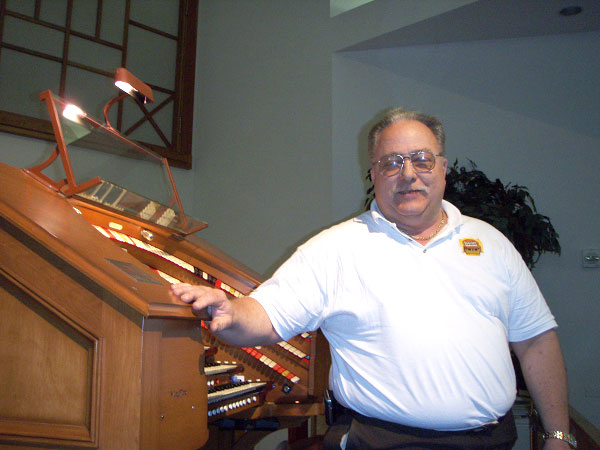
Good Luck With Your jOrgan Project,
Best Regards,
Kent Allman
Kent Allman at the J. Tyson Forker 4/32 WurliTzer

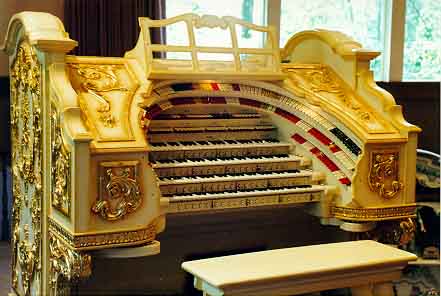
Symphonic III 3 Manual 36 Rank Orchestral Synth
Theatre 3-14 (SB or SFZ) 3 Manual 14 Rank Unit Orchestra
This is a very small screen shot of the Theatre 3-14 jOrgan Console (Disposition)
The 3-14 Consoles are set up to run on single instance of a SFZ Soft Synth (or a single Sound Blaster Card for testing) for lower CPU and memory requirments.
Please Note: If you run the 3-14 SB console with a single Sound Blaster card you will be limited to the SB cards 64 note Polifany and some SB cards will only play 8 channels of Multitimbrality. the Primary Purpose for this console is to enable you to test your setup to get everything working. It is highly recommended that you use the 3-14 SFZ version for your instrument instead of the 3-14 SB.
Click Here or Scroll Down On this page for the Free Download of this Console
Click Here or Scroll Down On this page for the Free Download of this Console
Click Here or Scroll Down On this page for the Free Download of this Console
Click Here or Scroll Down On this page for a Free Download of these Organs
The SymphIV Group is for people using or are interested in using the Allman Symphonic or Theatre Series of jOrgan Consoles
